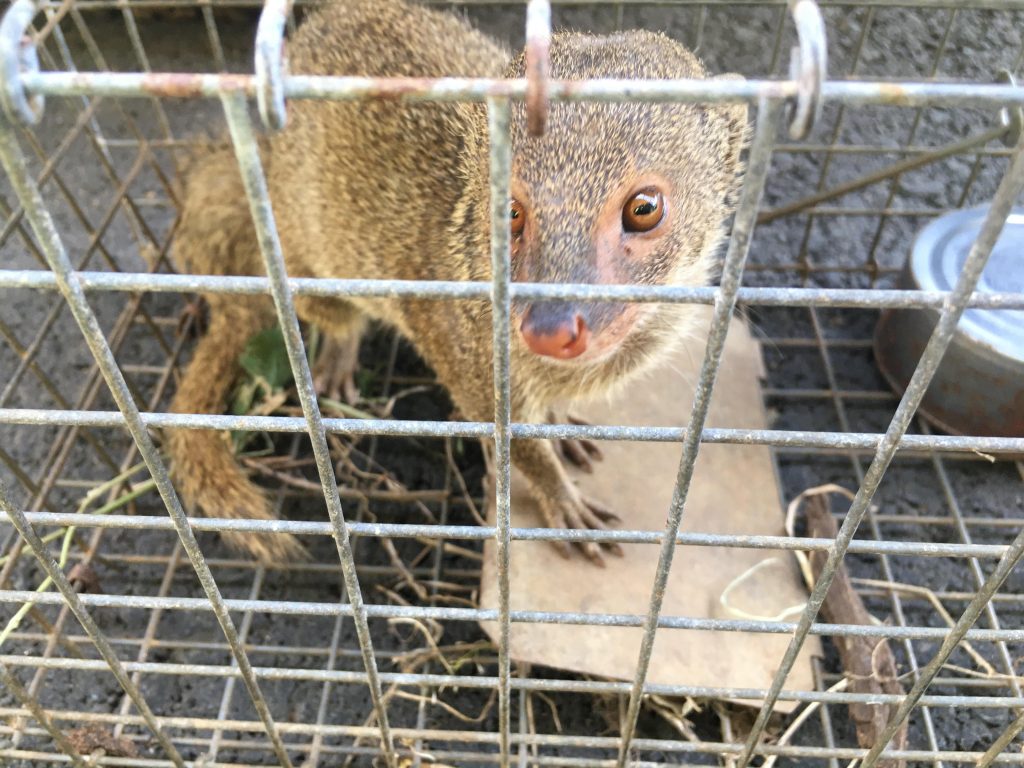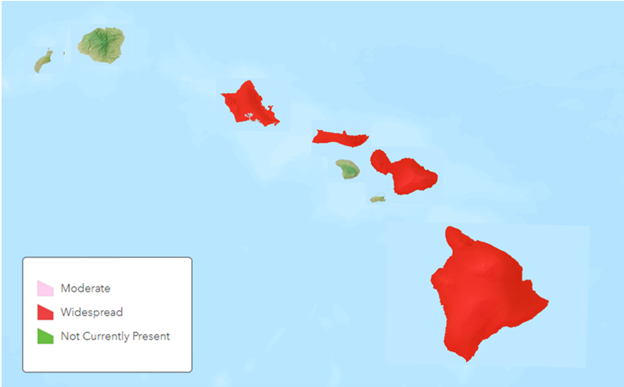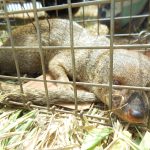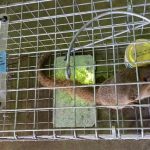Mongoose (Urva auropunctata)
Mongoose (Urva auropunctata)

- What You Can Do: Report this species to 643pest.org or call 808-643-7378 (643-PEST) if seen on Kaua’i or Lana’i.
- Regulatory Status: Hawai’i Injurious Wildlife (HAR 124). It is against Hawai’i State law for any person to introduce, keep or breed any mongoose within the State except by permit from HDOA; permits are not issued for Kaua’i County or the island of Lana’i. Fines for violations are between $250 and $1,000 for each mongoose introduced, kept or bred. HDOA Animal Industry Division Quarantine Rules HAR 142-92.
- Prevention and Control Category: KISC Target Species.

2023 capture on Kauaʻi
- 2012 capture on Kauaʻi
- 2016 capture on Kauaʻi
Photo credit above: KISC

DESCRIPTION:
- Mongoose are a weasel-like animal totaling about 26″ in length with a long, brownish body, short legs and a tail as long as its body.
- They have small rounded ears and a pointed nose.
- The mongoose is active during the day and generally sleeps in dens at night.
IMPACTS:
- Mongoose are opportunistic feeders that will eat birds, small mammals, reptiles, insects, fruits, and plants.
- They prey on the eggs and hatchlings of native ground nesting birds and endangered sea turtles.
- The small Indian mongoose has been blamed with the extinction of ground-nesting birds in Jamaica and Fiji and commonly kill birds, including 8 federally listed endangered Hawaiian birds, such as the Hawaiian crow (‘alalā), petrels (ʻuʻau) and Hawaiian goose (nēnē).
- It was estimated in 1999 that mongoose cause $50 million in damages to Hawai`i and Puerto Rico annually.
DISTRIBUTION/HISTORY:
- The mongooses found in Hawai’i are native to India and were originally introduced to Hawai’i Island in 1883 by the sugar industry to control rats in sugarcane fields on Maui, Moloka’i and O’ahu.
- The introduction of mongoose was misguided- while rodents make up a large portion of the mongooses’ diet, their substantial negative impact on other desirable birds, insects, and animals outweighs their minor impact on rat populations.
- Mongoose are now widespread on Hawai’i island, O’ahu, Maui, and Molokai (It is not necessary to report sightings on these islands).
- There are no known populations on Lanaʻi and Kauaʻi.
- Mongooses can live in both wet and dry conditions including gardens, grasslands, and forests.
WHAT YOU CAN DO:
- If you see this species on Kauaʻi or Lanaʻi call 808-643-7378 (643-PEST) or visit 643pest.org.
WHY THE MONGOOSE IS NOT CONSIDERED AN EXAMPLE OF BIOCONTROL:
- While the introduction of mongoose to Hawai’i is often casually referred to as an example of biological control gone wrong, the introduction of this species by private individuals in the sugarcane industry was not part of any scientific biological control process.
- Biological control, or “biocontrol,” is a robust scientific field in which research is done to identify a predator or pest of a given invasive species from its home range. This is followed by extensive research to determine whether the predator or pest- if introduced to Hawai’i- would impact only the invasive species in question.
- Mongoose did not undergo this evaluation prior to entry and should not be considered an example of biocontrol.
- You can learn more about modern biocontrol efforts at the HDOA Plant Pest Control, Biological Control Section website.
REPORTS ON KAUAʻI (INFO FROM KISC):
- Including the latest capture in April 2023, there have been a total of 5 live mongooses apprehended Kaua‘i.
- One female mongoose was found dead along a road in 1976 near Kalaheo, and sightings have been reported all over the Garden Island.
- In May 2012, the first mongoose was trapped at a resort near the Lihue Airport and the second was captured at Nawiliwili Harbor.
- In 2016, a mongoose was captured in the cargo area at Lihue Airport, and one was a trapped at Nawiliwili Harbor in 2021.
- We would not be successful in preventing the establishment of mongoose on Kauaʻi without the Kauaʻi community, specifically the vigilant employees at the airport and harbor.
For more information
- Mongoose – KISC
- Development of Mongoose Control Tools – DLNR
- Mongooses on Maui – Maui Forest Bird Recovery Project
- NY Times, An Invader Advances in Hawaii. 2012
- Biology and Impacts of Pacific Island Invasive Species. A Worldwide Review of Effects of the Small Indian Mongoose, Herpestes javanicus (Carnivora: Herpestidae). 2007. Hays and Conant.

